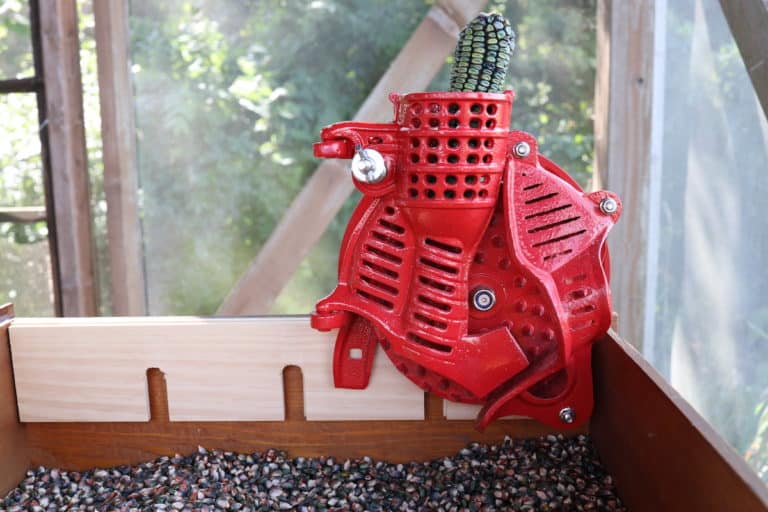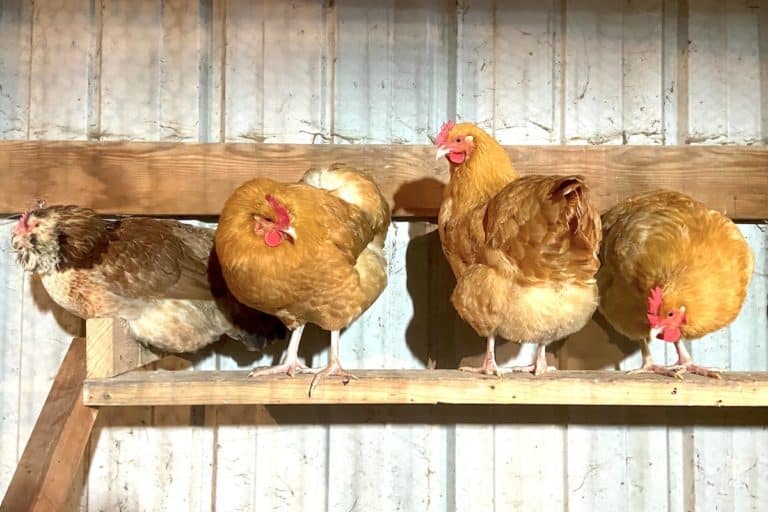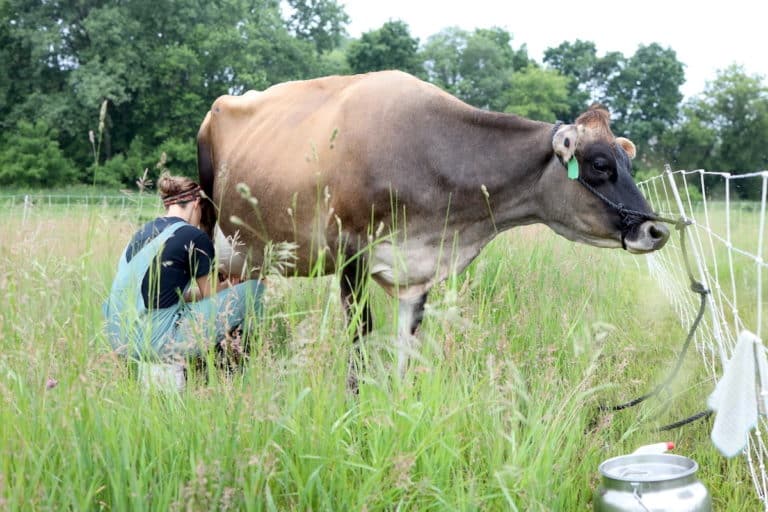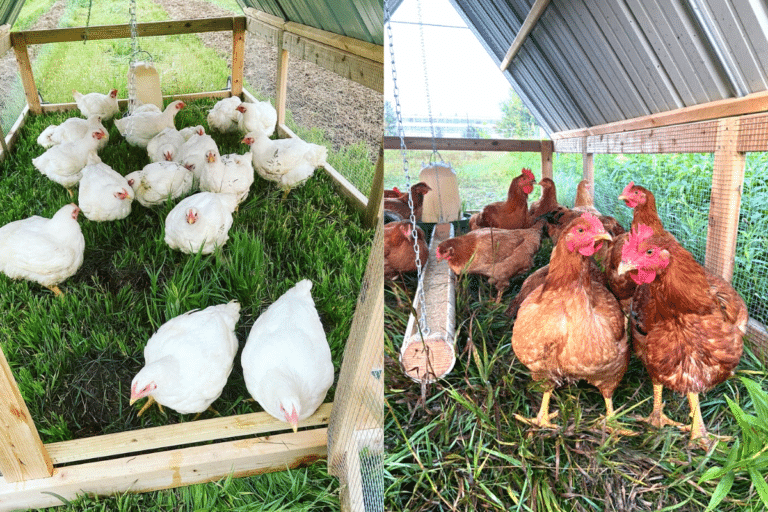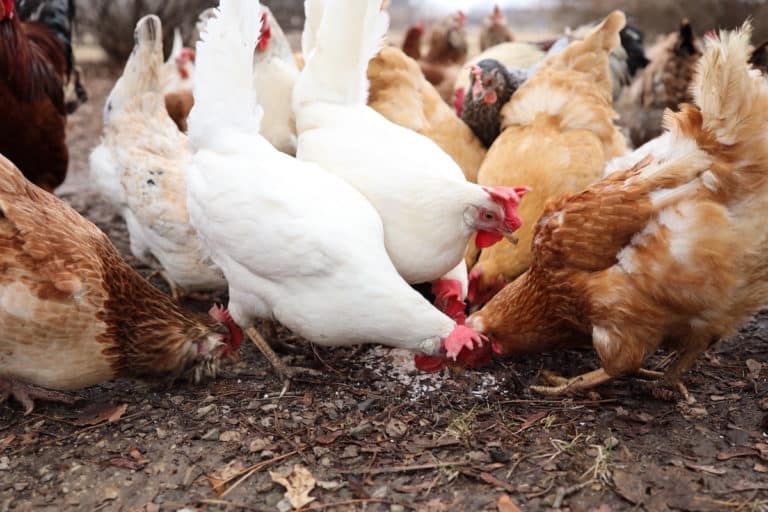10 Essential Storage Crops You Need To Grow
When it comes to storage crops, there are so many possibilities! We’ll focus on 10 essential storage crops that will keep you well fed all winter and make you less reliant on the grocery store.
In 2019 our gardening strategy shifted from what can we grow “in season,” to, “how can we we feed our family year round?” Suddenly, with the addition of storage crops, our gardens looked very different and we were blown away with the outcome!
Growing LOTS of Food with LITTLE Space
Yes, we have a 5 acre homestead. But, only a fraction of that space is used to grow the couple thousand pounds of storage crops that feed our family all year round.
We have two gardens.
One is our kitchen garden where we grow in-season veggies like tomatoes, kale, peppers, ground cherries, broccoli, and brussels sprouts.
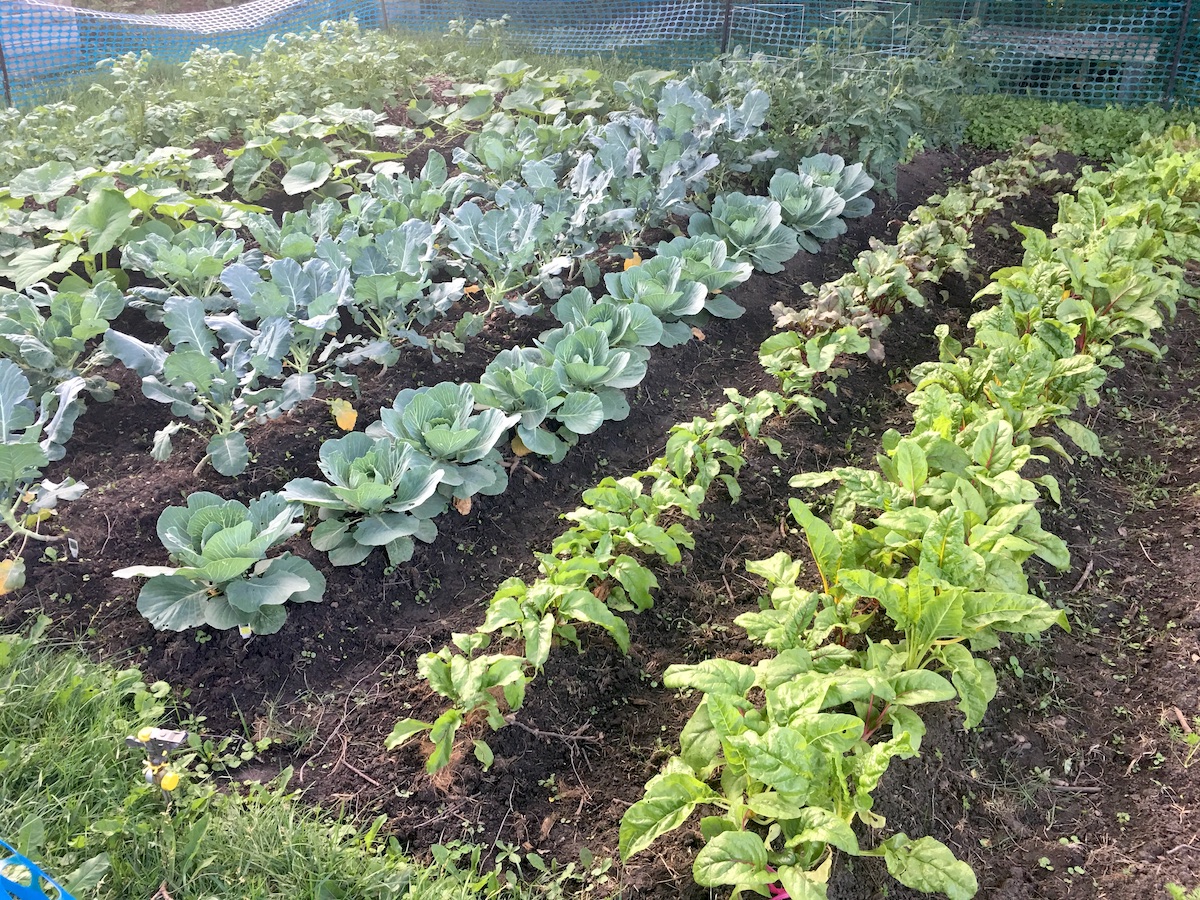
The other garden we call our three sisters garden. Here we grow long rows of the three sisters companion planting method (corn, dry beans, and squash) along with potatoes and other root vegetables. This garden space also contains 30 young fruits trees – apple, pear, and others – containing many varieties that are suitable for long term storage.
In total, our garden spaces are less than 1/8 acre. A size that can easily be carved out on many rural, suburban, and possibly even urban lots.
In this space, we are able to annually produce:
- Over 100 winter squash
- ~1,000 lbs. of potatoes
- Several quarts of dry beans
- Buckets of dent corn
- Bushels of fruit
- Enough other produce to can, freeze, dehydrate, or keep in the fridge to last us to the next growing season.
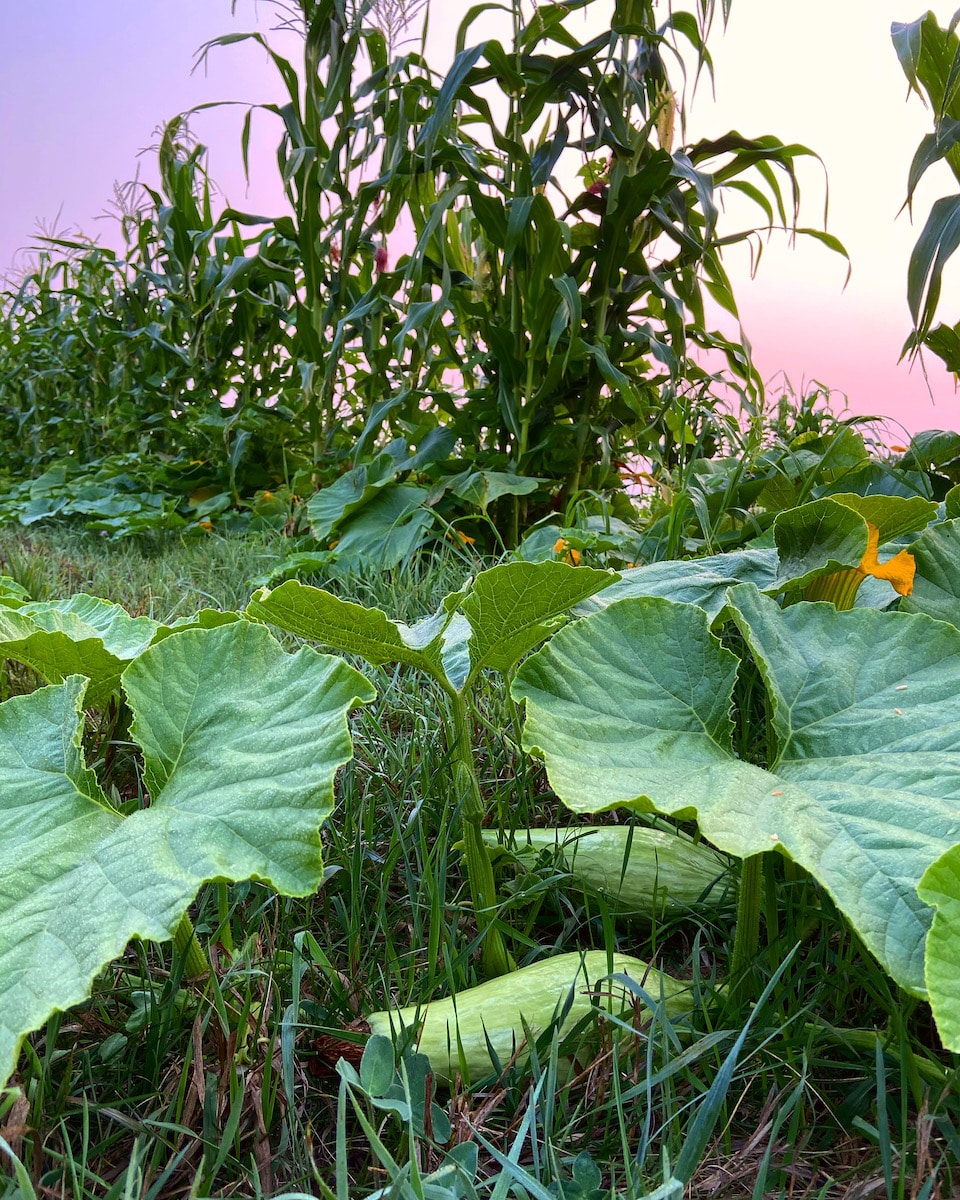
In the end, we did it! With these storage crops, along with the meat and dairy we produce on our homestead, we able to produce over 80% of our food right on our farm.
But storing all that food was another big learning curve.
How We Store Storage Crops in Our Basement
When you think storage crops, a root cellar probably comes to mind. Well, we didn’t have one. Nor did we have the time or resources to build one.
BUT we did have an unheated basement!
Was that ideal? Maybe not. But with no other options, we decided to give it a shot! This video walks you through our basement food storage system.
What we discovered is that a basement can be a great place to store long term storage crops! As long as your space can remain dark, dry, and maintain a consistent cool temperature of around 50-55°F then you’re in business.
Food storage doesn’t have to be fancy or expensive. Our philosophy is to work with what you have or search for needed items second hand. With just a few basic components you can setup your own food storage area.
Basic Components Needed to Store Food Long Term:
Storage shelves
Whether building or buying shelves, you want them to be substantial! Imagine a couple hundred pounds of potatoes or glass canning jars on each shelf – that’s some precious and heavy cargo to support! We were so grateful to have picked up two of the Gladiator brand storage shelves from a friend who was moving. These shelves are heavy duty and also perfectly fit the standard sized food storage bins we already had.
Storage containers
Plastic food storage bins are any gardener’s best friend. We use them for harvesting all season long and then store potatoes, corn, and other crops in them during the winter months. You can purchase them new. But we’ve found they’re easy to come by used on FB Marketplace or Craigslist as many grocery stores, restaurants, or food distributers are looking to get rid of them. Food grade 5-gallon buckets also come in handy – we got some used ones recently from the local donut shop!
Aside from that, use what you have. Cardboard boxes, brown paper bags, laundry baskets, storage bins, empty dresser drawers, mason jars. They don’t need to look pretty; just be functional for storage!
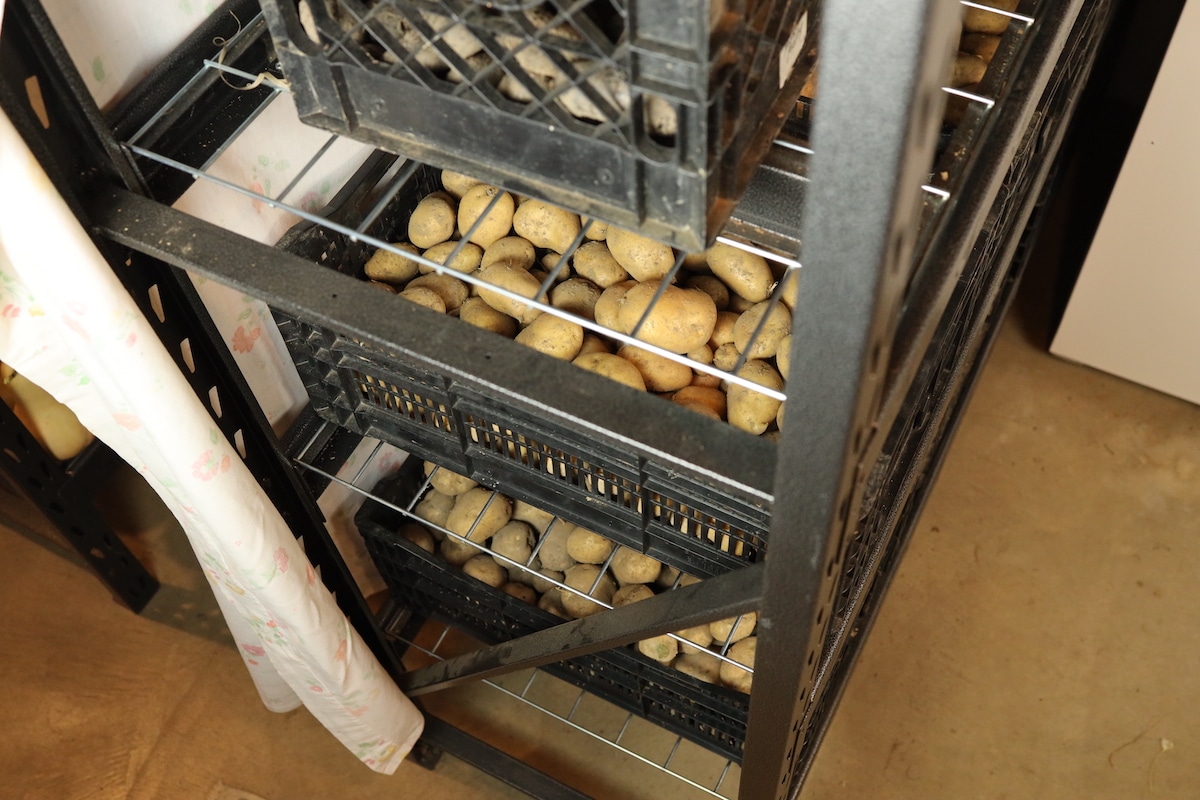
A spare refrigerator (or two!)
The basement is great for COOL storage crops (potatoes, squash, dry beans), but when it comes to COLD storage crops a refrigerator comes to the rescue. In addition to the fridge in our kitchen, we came across two used refrigerators and boy are we grateful for them. One is in our basement and one in our garage. Come fall harvest season, these fridges get loaded up with cabbage, apples, carrots, beets and other storage crops to keep them fresh for months.
10 ESSENTIAL STORAGE CROPS FOR LONG TERM STORAGE
When it comes to storage crops, you want the best bang for your buck along with a tried and true recipe. Yes, you can find lists out there with 30 or more storage crop options. But after researching what’s out there and growing them ourselves, we’ve landed on 10 crops optimized for long term storage that offer the most nutrition, caloric energy, and versatility in the kitchen.
1. Winter Squash
Winter squash are the ultimate storage crop. Thick skinned late season squash, when properly cured, can last for 6-12 months. We still have a couple left from October of last season that are firm and perfectly edible – that’s over a year! They will require some space to grow as squash vines like to sprawl and climb up anything in their path. But after planting in the spring, the plants require very little attention until fall harvest. The flesh can be roasted and/or pureed and turned into so many dishes and sides.
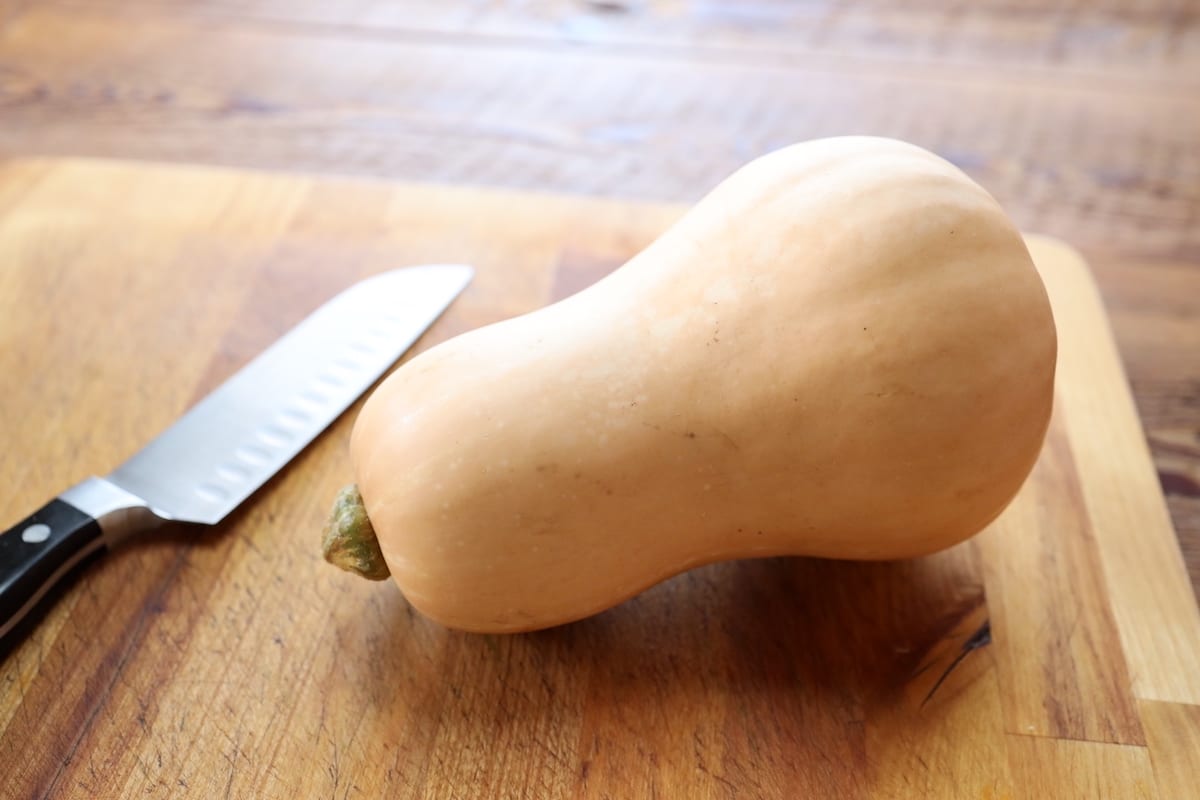
Best Winter Squash Varieties
Butternut
Sibley
Hubbard
How To Store Winter Squash
Allow to ripen on the vine as long as possible but harvest before they run the risk of freezing. Once harvested, cure indoors at a moderate temperature by laying them out in a single layer so that the skins are not touching each other and leave for 10-14 days. Curing will thicken the skin of the squash and allow any blemishes to heal for best storage. Cured squash can then be stored on shelves or in bins at a temperature of 45-55°F. Large squash store best, so eat through the smaller ones first. And if a squash is not ripe when harvested, they can be left to ripen off the vine and then go through the same curing process for storage.
2. Dry Beans
Dry beans are fun to grow and provide a great source of protein through the winter months. There are pole bean and bush bean varieties. Pole beans climb and require a trellis. Bush beans grow compactly and can typically support themselves. Beans are an integral part to our three sisters garden where they trellis up the corn stalks. Dry beans are a staple in many diets around the world due to their high protein content. But the tedious process of harvesting and shelling beans by hand – removing the outer pod – will give you a new appreciation for this storage crop as compared to more industrialized harvesting and shelling methods.
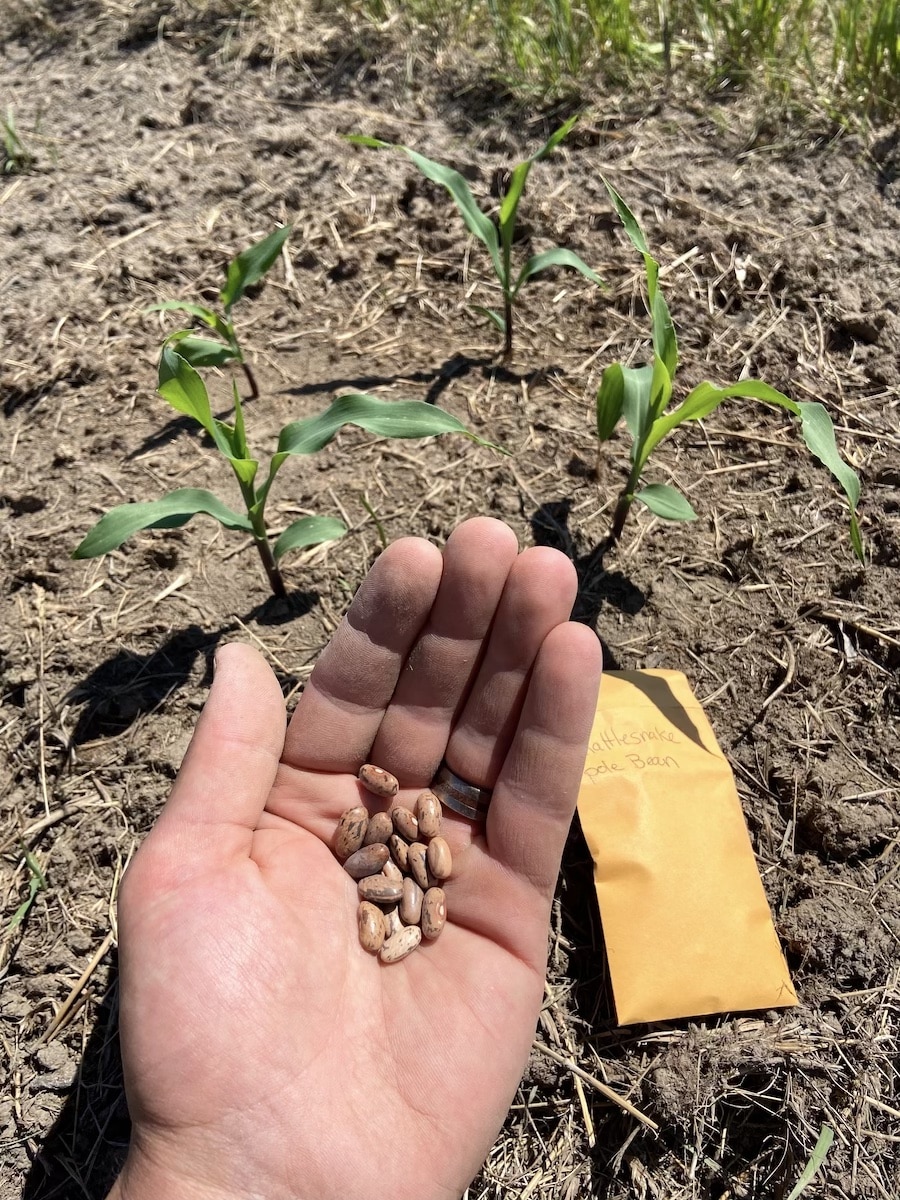

Best Dry Bean Varieties
There are hundreds, but these are a couple we grow:
Rattlesnake Pole Bean
Beefy Resilient Grex Dry Bush Bean
How To Store Dry Beans
Once the bean pods have dried out on the vine, the pods are ready to harvest and then be shelled. If the bean pods still contain moisture, allow them to dry out before shelling. Remove any beans that have sprouted. Shelled beans can then be placed in air tight mason jars or buckets for long term storage. Store in a cool, dark, and dry place and beans can stay fresh for months, even years.
3. Corn
Corn has long been utilized as a source of caloric energy to help people survive the cold winter months. Today, a singular yellow dent corn dominates what is grown for animal consumption. But many more heirloom varieties that are colorful and nutritious still exist and can be grown in a wide variety of climates. When dried and properly stored, corn will stay viable for years making it a great storage crop to stock up on. When ground into cornmeal, there are many culinary uses besides the standard cornbread – which is still quite delicious. Cornmeal can also be used for porridge and polenta or go through the process of nixtimilization to make masa – the main ingredient for tortillas. Popcorn varieties are great too!
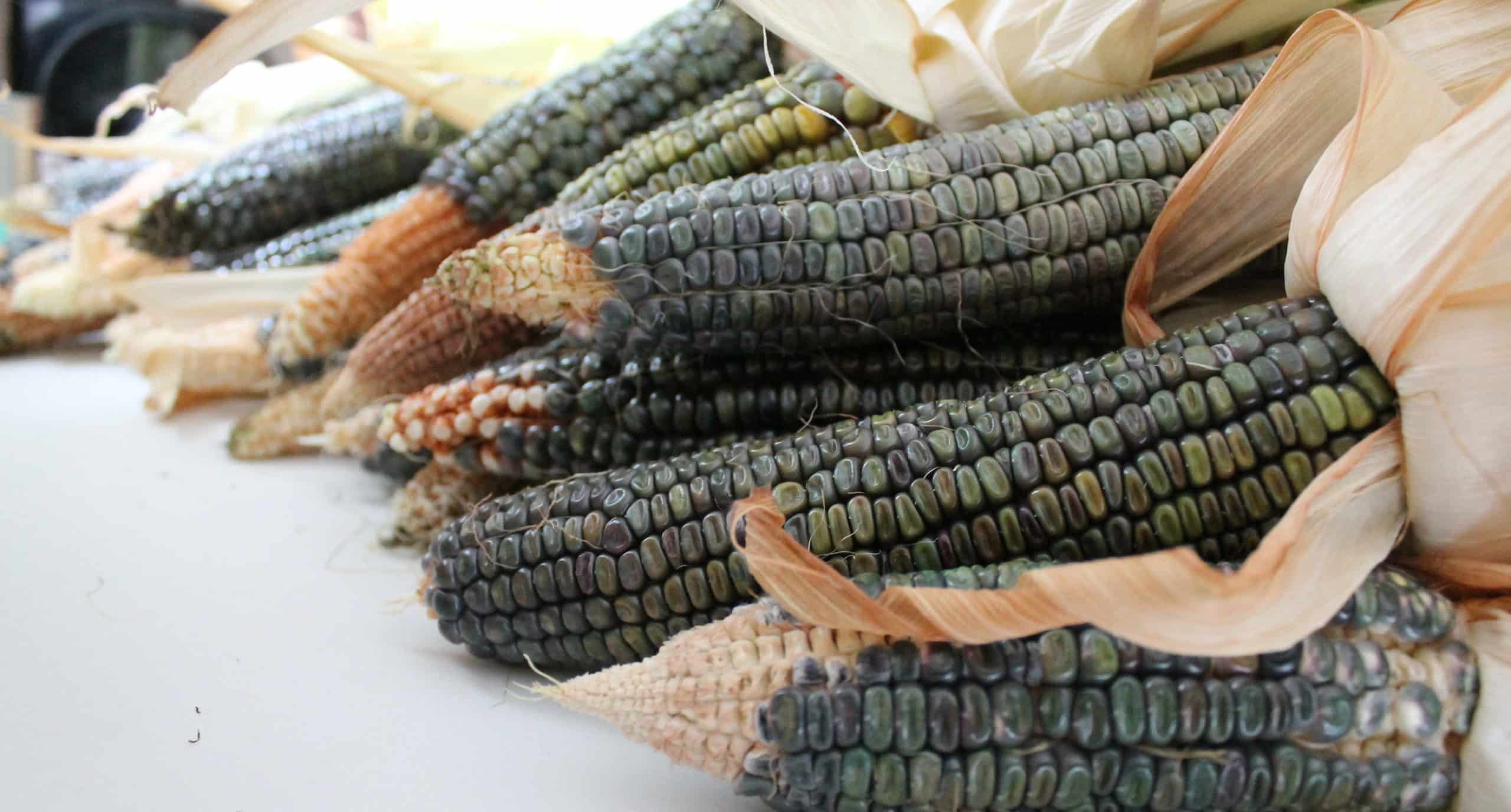
Best Storage Corn Varieties
Again, there are hundreds, but here’s some we recommend:
Oaxacan Green Dent
Magic Manna
Parching Red Supai
Dakota Black Popcorn
How To Store Corn
After corn stalks have transitioned from green to yellow, the ears can be harvested. Once harvested, the ears are shucked by removing the husk. Shucked corn can then be hung or laid out in a well-ventilated space to dry out for 4-6 weeks. Once dried, the ears can either be stored as-is in a box or bin. Or you can shell them, which is the process of removing the kernels, and store the kernels in a jar or bucket.
4. Potatoes
If there were a storage crop awards ceremony, potatoes may walk away with the most nominations. They allow for truly year round eating. Plant potatoes early in the spring and you can begin harvesting them as early as mid-summer to enjoy in the kitchen right away. Letting them continue to grow and cure underground will optimize them for long-term storage where they can stay firm and fresh as long as 8 months. Baked or roasted, cubed or French fried, there’s no wrong way to enjoy a potato.
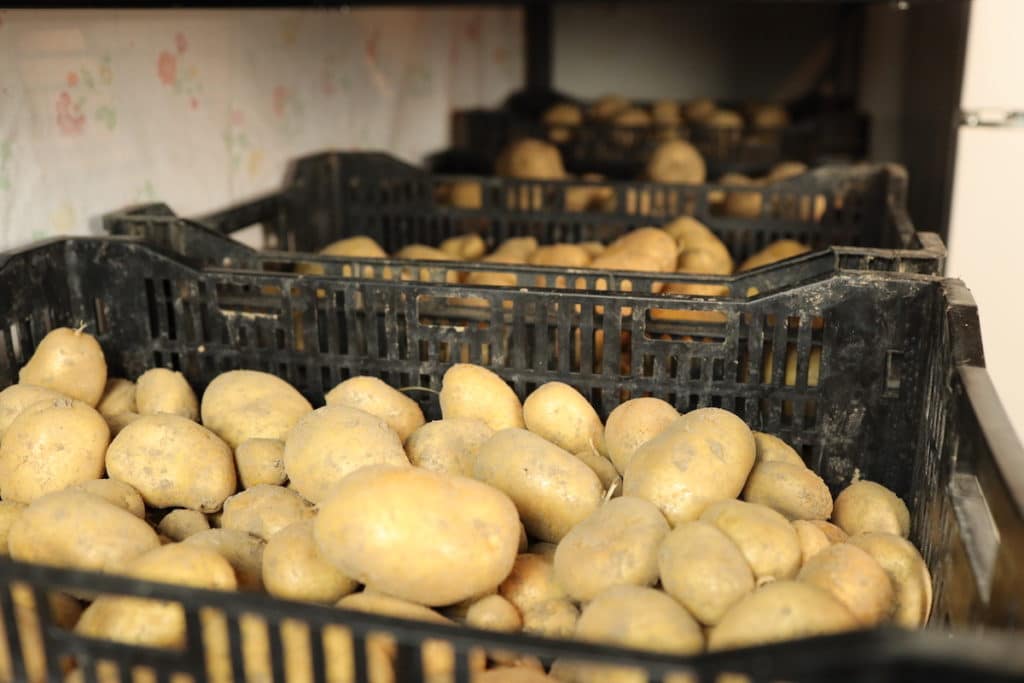
Best Storage Potato Varieties
Many potato varieties exist, but these varieties are best suited for storage potatoes. Look for varieties that are mid- or late-season varieties. White or yellow potatoes tend to store better than red or purple.
Elba
Yukon Gold
Russet
German Butterball
Carola
How To Store Potatoes
Similar to squash, potatoes also should go through a curing process where they are laid out in a single layer for 7-10 days at a moderate temperature that will cause their skin to thicken. After this, store potatoes in a breathable paper bag, box, or bin and keep in a dark environment at a constant temperature of 45-55°F. Potatoes can be kept in high moisture spaces. For a more in depth look at potato storage check out our post – How To Store Potatoes from the Garden Long Term.
5. Apples
Apples are a welcome and yummy sweet treat in the winter months! A single apple tree can provide up to 800 lbs of fruit in a season making them a truly worthwhile investment in your yard. They’re also versatile and can be turned into cider and sauce. They can also be baked, eaten fresh, or used to sweeten up or compliment many other dishes. We can many quarts of applesauce each year to have on hand. And we also save a bushel or two to keep through the winter months for various uses. We love to make this GF apple bread!
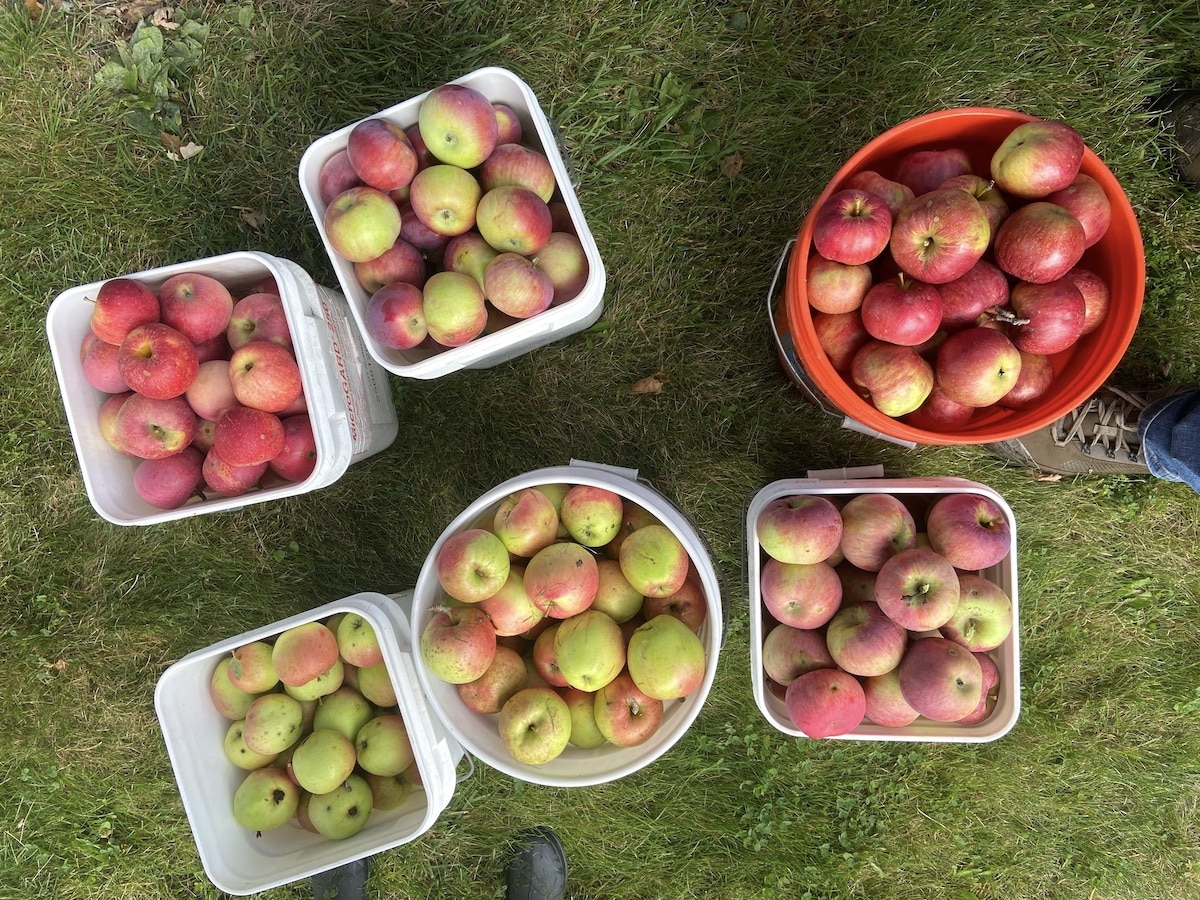
Best Storage Apple Varieties
Black Oxford
Northern Spy
Fuji
Goldrush
Ida Red
How To Store Apples
Applesauce is a great way to preserve apples for use all year round. Cider is another great option. To store whole apples, simply store in the fridge. Storage varieties will stay fresh in the refrigerator for 6 or more months.
6. Cabbage
Cabbage are a lovely contrast to the hearty, carbohydrate rich root veggies. Without a greenhouse, we are only able to enjoy most greens and lettuce in the summer months when they are in season, besides those that we dehydrate. However, cabbage can make a lovely winter salad or be used in a wide range of cooked dishes.

Best Storage Cabbage Varieties
Storage #4
Ruby Perfection
Kaitlin
Red Kalibos
Mudroc
How to Store Cabbage
Cabbage stores best in a cold (32-40°F) and humid environment. A fridge is a good option for storing for several weeks (and what we are currently using) but a root cellar is more ideal to give cabbage the humidity that a fridge doesn’t provide. If we notice our cabbage starting to turn, we turn them into sauerkraut for longer term storage.
7. Carrots
Roots veggies lend themselves to storing well and we loved enjoying our carrots deep into the spring last year. Being both rich in nutrients and calories and so versatile in cooking, carrots are an excellent choice for growing in abundance.
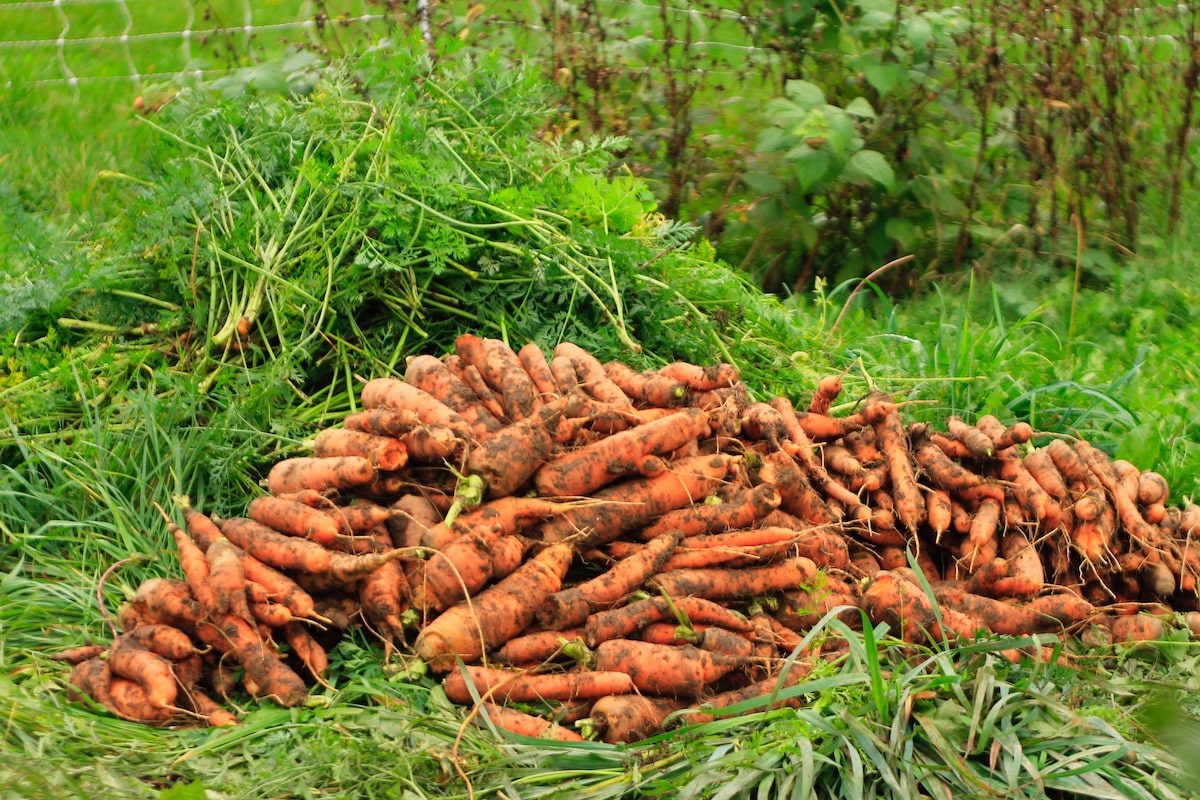
Best Storage Carrot Varieties
Bolero
Danvers
Napoli
Yellowstone
How to Store Carrots
Carrots can be stored a variety of ways but the first step is to remove the greens from the carrots for long term storage and leave them unwashed. They can store well in a refrigerator, root cellar, or in sand in a cool place. When stored properly, carrots can store well for many months.
8. Onions/Leeks
Onions or leeks are wonderful to have on hand to complement and provide lovely flavor to so many dishes.

Best Storage Varieties of Onions/Leeks
There are way more varieties than listed here.
Yellow Of Parma
Bridger
Cortland
White Sweet Spanish
Brunswick
How to Store Onions/Leeks
Leeks do best stored around 32 degrees Fahrenheit and can store this way for several months. We keep our leeks in the fridge for long term storage. Onions need to be cured too before storing long term to harden their skins. Once cured, onions store best in a cool, dark place around 40-45°F. It’s important to store onions away from potatoes because the gases emitted will cause either to sprout and spoil much more quickly.
9. Beets
Similar to carrots, this hearty root vegetable also is great for storage. Around here, beets are synonymous with our chocolate beet muffins and are the first thing the kids ask for whenever they see beets hanging around. We also love roasting beets as a side or to add to a veggie hash.
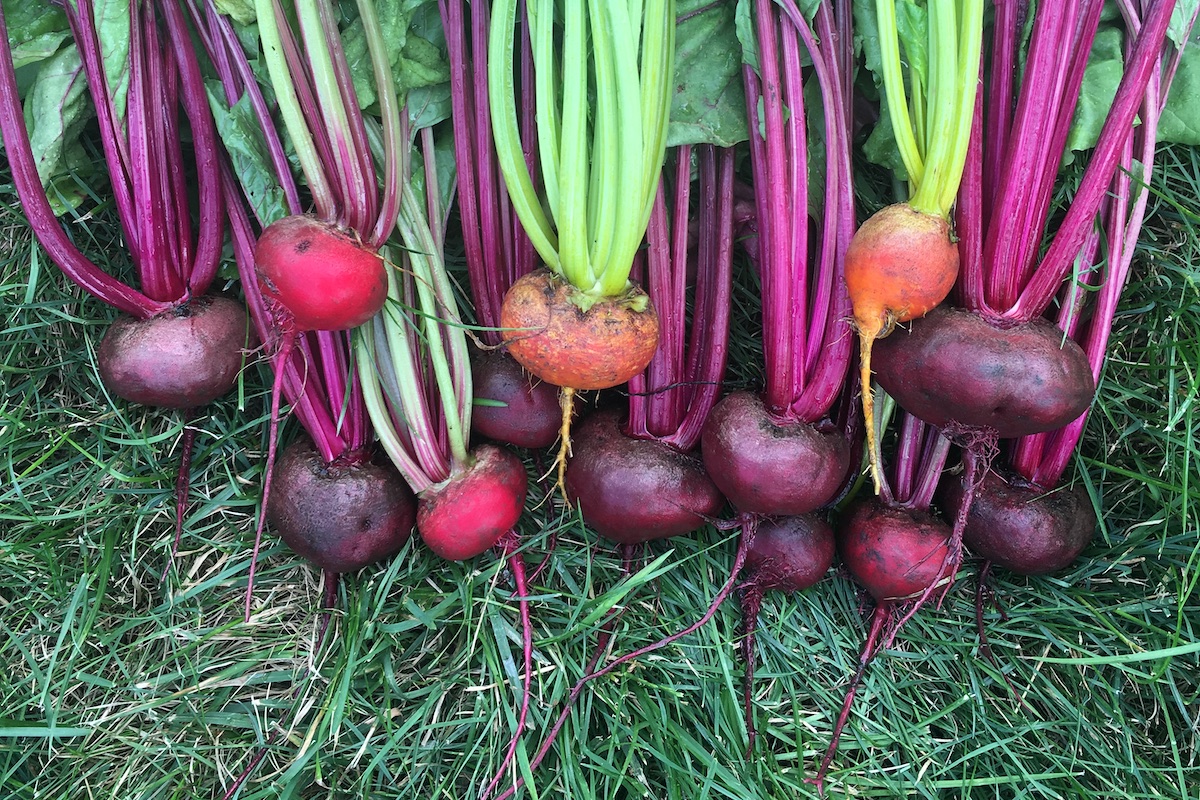
Best Storage Variety of Beets
Merlin
Rhonda
Detroit Dark Red
Golden
How to Store Beets
After harvesting, the greens must be removed from beets for long term storage. Keep remaining beets unwashed, as the waxy layer on the skin helps them to store better. Store in plastic bags or produce bags in the fridge. Check on them regularly and remove any that have begun to get soft. We have successfully stored beets this way for at least 5-6 months.
10. Garlic
As opposed to all of the other crops here that are planted in the spring and harvested in the fall, garlic is different. Garlic is planted in the fall (usually we shoot for the second half of October) and harvested in the spring or early summer. While garlic doesn’t provide much in terms of energy from calories, it makes up for it in flavor and robust medicinal properties.
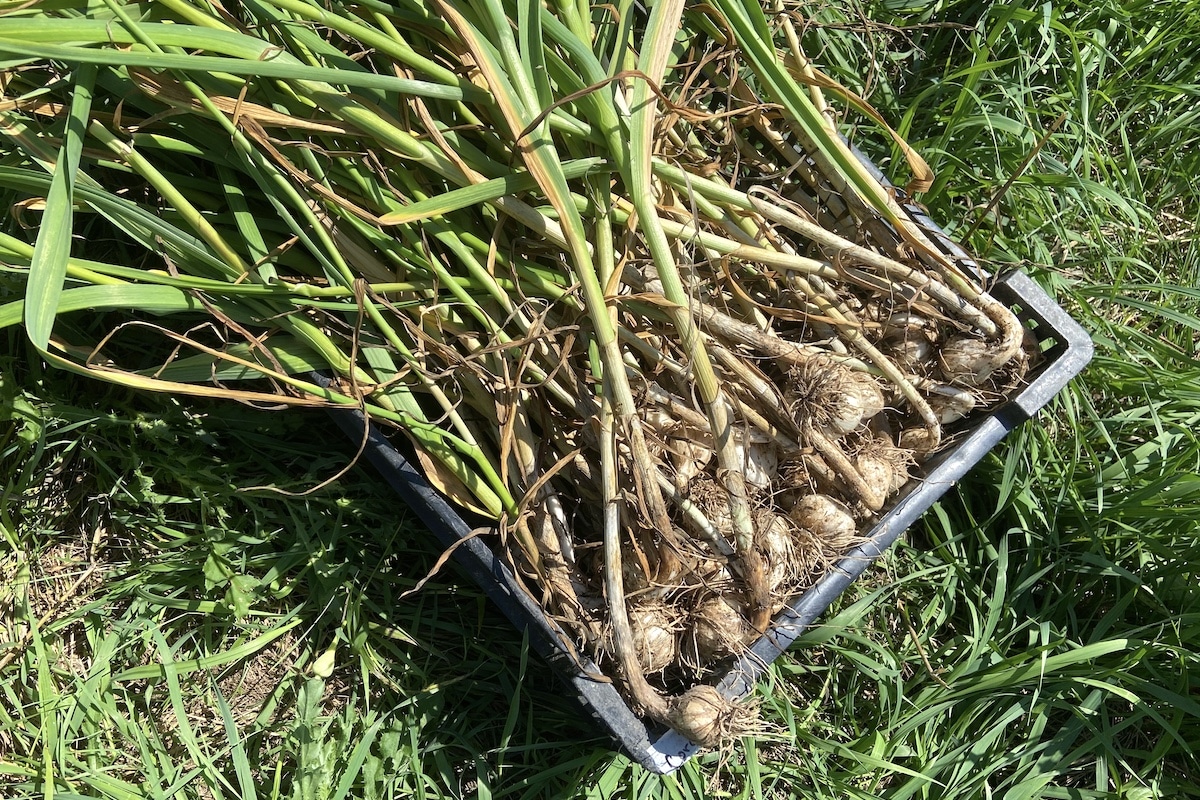
Best Storage Varieties of Garlic
Silverskin
Creole
Artichoke
How to Store Garlic
Garlic is stored unpeeled at room temperature in a dark place. Stored this way they can keep for several months. Softneck garlic varieties tend to store better than hard neck varieties and can easily keep for up to a year. Hardneck varieties can still keep well for several months.
These are the main crops we plan our garden around with the addition of others that we preserve by canning, freezing or dehydrating. What has been your experience storing food through the winter?
Some of the above links are affiliate links. This means we earn a small commission on qualifying purchases at no cost to you. We are so appreciative of your support!
Pin it for later!


